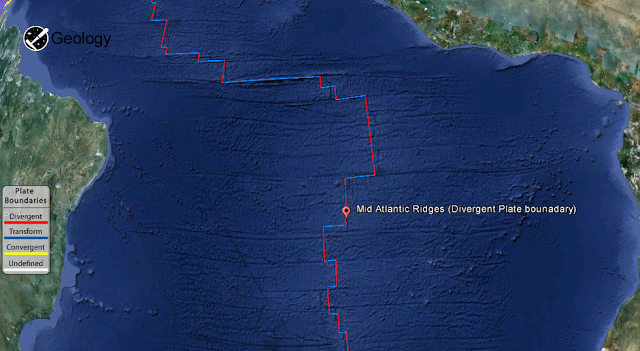How Does the Mid Atlantic Ridge Continue to Push Europe and North America Further Apart

The Mid-Atlantic Ridge (MAR) is a mid-ocean ridge, a divergent tectonic plate boundary located along the floor of the Atlantic Ocean, and the longest mountain range in the world.
It separates the Eurasian Plate and North American Plate in the North Atlantic, and the African Plate from the South American Plate in theSouth Atlantic.
The Ridge extends from a junction with the Gakkel Ridge (Mid-Arctic Ridge) northeast of Greenland southward to the Bouvet Triple Junction in the South Atlantic. Although the Mid-Atlantic Ridge is mostly an underwater feature, portions of it have enough elevation to extend above sea level. The section of the ridge which includes the island of Iceland is also known as the Reykjanes Ridge. The average spreading rate for the ridge is about 2.5 cm per year.
Discovery
A ridge under the Atlantic Ocean was first inferred by Matthew Fontaine Maury in 1850. The ridge was discovered during the expedition of HMS Challenger in 1872. A team of scientists on board, led by Charles Wyville Thomson, discovered a large rise in the middle of the Atlantic while investigating the future location for a transatlantic telegraph cable. The existence of such a ridge was confirmed by sonar in 1925 and was found to extend around the Cape of Good Hope into the Indian Ocean by the German Meteor expedition.
In the 1950s, mapping of the Earth's ocean floors by Bruce Heezen, Maurice Ewing, Marie Tharp and others revealed the Mid-Atlantic Ridge to have a strange bathymetry of valleys and ridges, with its central valley being seismologically active and the epicentre of many earthquakes. Ewing and Heezen discovered the ridge to be part of a 40,000-km-long essentially continuous system of mid-ocean ridges on the floors of all the Earth's oceans. The discovery of this worldwide ridge system led to the theory of seafloor spreading and general acceptance of Wegener's theory of continental drift and expansion as plate tectonics.
Geology
The ridge sits atop a geologic feature known as the Mid-Atlantic Rise which is a progressive bulge that runs the length of the Atlantic Ocean, with the ridge resting on the highest point of this linear bulge. This bulge is thought to be caused by upward convective forces in the asthenosphere pushing the oceanic crust and lithosphere.
This divergent boundary first formed in the Triassic period when a series of three-armed grabens coalesced on the supercontinent Pangaea to form the ridge. Usually only two arms of any given three-armed graben become part of a divergent plate boundary. The failed arms are called aulacogens, and the aulacogens of the Mid-Atlantic Ridge eventually became many of the large river valleys seen along the Americas and Africa (including the Mississippi River, Amazon River and Niger River).
The ridge is about 2,500 meters (8,200 ft) below sea level, while its flank is about 5,000 metres deeper.
The Fundy Basin on the Atlantic coast of North America between New Brunswick and Nova Scotia in Canada is evidence of the ancestral Mid-Atlantic Ridge.
Notable Features Along the Ridge
The Mid-Atlantic Ridge includes a deep rift valley which runs along the axis of the ridge along nearly its entire length. This rift marks the actual boundary between adjacent tectonic plates, where magma from the mantle reaches the seafloor, erupting as lava and producing new crustal material for the plates.
Near the equator, the Mid-Atlantic Ridge is divided into the North Atlantic Ridge and the South Atlantic Ridge by the Romanche Trench, a narrow submarine trench with a maximum depth of 7,758 m (25,453 ft), one of the deepest locations of the Atlantic Ocean. This trench, however, is not regarded as the boundary between the North and South American Plates, nor the Eurasian and African Plates.
Islands on the Mid-Atlantic Ridge
The islands, from north to south, with their respective highest peaks and location, are:
Northern Hemisphere (North Atlantic Ridge):
- – Jan Mayen in the Arctic Ocean Iceland through which the ridge runs
- – Azores (Ponta do Pico or Pico Alto, on Pico Island)
- – Bermuda was formed on the ridge, but is now considerably west of it
- – Saint Peter and Paul Rocks
Southern Hemisphere (South Atlantic Ridge):
- – Ascension Island (The Peak, Green Mountain) Tristan da Cunha (Queen Mary's Peak)
- – Gough Island (Edinburgh Peak)
- – Bouvet Island
More Information About :
Plate Tectonics Map
Plate Boundary Map
Note : The above story is reprinted from materials provided by Wikipedia
Plate Boundary By : USGS
sullivanhungs1936.blogspot.com
Source: https://www.geologypage.com/2013/01/mid-atlantic-ridge.html
0 Response to "How Does the Mid Atlantic Ridge Continue to Push Europe and North America Further Apart"
Post a Comment